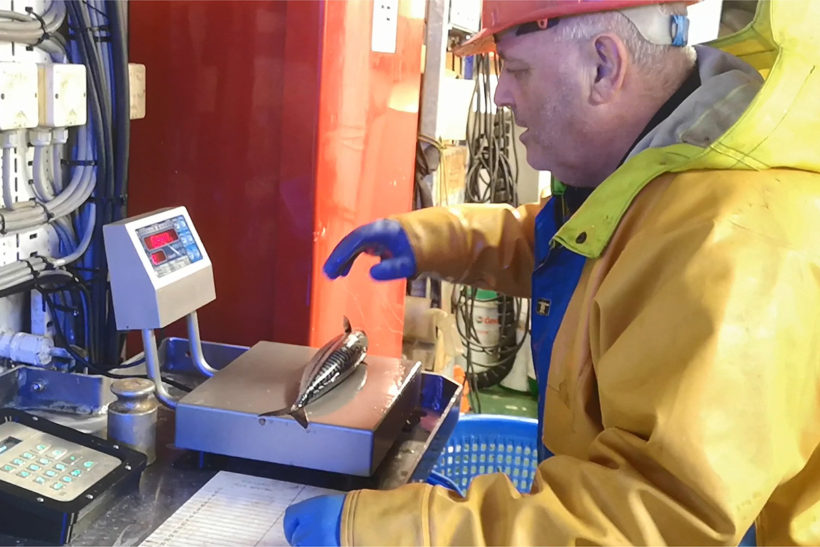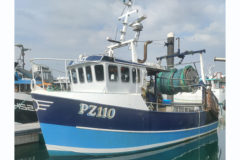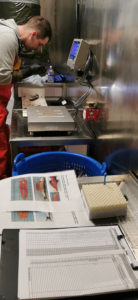
Sampling is now carried out by Scottish pelagic crews as a routine part of every haul.
Fishing News recently reported that Scottish pelagic vessels now actively participate in gathering the biological data that inform how fisheries are managed. This new collaboration between fishers and scientists not only provides high-quality data on herring, mackerel and blue whiting stocks, but also builds understanding and trust between science and industry. Here, the scientists involved in the programme explain how this collaboration works
Starting as a pilot project in 2018, the Scottish Pelagic Fishermen’s Association (SPFA), Shetland UHI and the Marine Scotland directorate of the Scottish government developed a voluntary scheme that went from sampling fish on the deck to entering data into the system.
The aim was to supply high-quality data to the International Council for the Exploration of the Sea (ICES), which carries out the stock assessments that inform fishery management. Seven pelagic fishing vessels participated in the pilot, which proved so successful that from 2021 almost all (20 of 21) of Scotland’s pelagic fishing vessels have been fully involved.

In the ‘self-sampling’ part of the programme, a set number of fish are put aside from each haul…
Since the 1970s, the Scottish government has collected most of its data on pelagic catch from processers when the fish are landed. Through this new collaboration, the fish samples are collected onboard by fishers, directly from their individual hauls. Sampling in this manner provides a higher level of detail, as well as collecting additional operational and environmental information.
Working together, fishers and scientists have developed logistically viable procedures to collect data at sea to supply to scientists for analysis. There are two different streams to the data collection process, called ‘self- sampling’ and ‘co-sampling’.
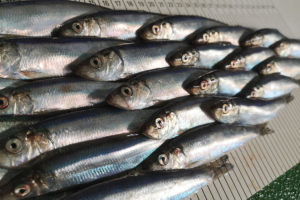
… and then measured onboard for length and weight.
‘Self-sampling’ means that the fishers themselves take measurements of the fish. Vessel crews take length and weight measurements from a set quantity of fish as each haul is pumped onboard.
This allows the precise time and location of catch to be connected to the biological data, along with other environmental parameters. Fish are sampled from every haul of every trip, providing length and weight data at high spatial resolution, with close to full fleet coverage.
Assessing the age, sex and maturity of each fish is a more time-consuming process requiring specialist knowledge, so a different approach is needed to collect these data. This is where ‘co-sampling’ is used.
Since 2020, vessel crews have been collecting fish from randomly selected trips. These samples are frozen at sea and taken to laboratories at Marine Scotland or Shetland UHI, where scientists defrost them and collect the biological information.
Gaining an understanding of the age structure of fish catches is essential to assess their health and to forecast their ability to remain sustainable in future years. The numbers at age in each sample are used to estimate the numbers at age in the total catch taken in each quarter and ICES area. These estimates, along with total reported catch weights, mean lengths and weights at age are provided to ICES for use in the stock assessments for each species.
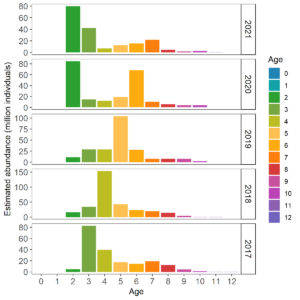
Starting as a pilot project in 2018, the sampling programme has now been rolled out to 20 of the 21 vessels in the Scottish pelagic fleet.
From the very beginning, the project has focused on ensuring the data collected are relevant and scientifically credible. To achieve this, the programme has worked in partnership with relevant scientific and policy institutions (national and international) to develop the specifics of the programme.
Any data provided by industry has the best chance of being used when it can demonstrate that it meets the required international standards of quality and documentation, allowing it to be trusted by the institutions that use it.
Collaborations allow the distinct expertise of each partner to be recognised, combined and shared. Within this collaboration, Shetland UHI staff manage the day to day implementation of the programme and work closely with the SPFA, delivering training and ongoing regular communication with vessels. Marine Scotland works with SPFA and Shetland UHI to design sampling methods, protocols and quality assurance and control to ensure that the data collected meets required standards.
The Scottish Fishermen’s Federation (SFF) is involved in the logistics of collecting and transporting samples to the laboratory. SFF is also engaged in strategic work that seeks to see how lessons from the pelagic sampling might be translated to other sectors.
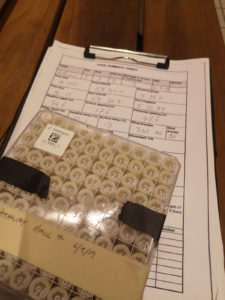
Aggregated data is shared with all participating vessels at the end of each season.
There are several benefits to this collaborative sampling scheme. Collecting data directly from vessels, rather than from markets, allows catch that is usually landed abroad to also be included in the sampling. The better a sampling programme is able to reach the full scope of a fishery, the more representative the data will be.
A further advantage to this new sampling approach is allowing greater control over how trips are selected for biological sampling. Random sampling of the fleet is the gold standard in sampling any fishery to produce unbiased results. In this scheme, the willingness of almost all the Scottish pelagic vessels to engage in the data collection has been key to combining random sampling with comprehensive coverage of the fishery.
A key part of the scheme is that, as owner of the data, every vessel has full access to the data it has collected. After every fishing season, summary reports and data sheets are sent to each participating vessel, providing both a summary of their results and how they compare with previous years.
A summary of the anonymised results of all participating vessels is also given to each participant at the end of each year. It should be noted that for data protection purposes all data are treated in the strictest confidence, and are aggregated before any reporting in the scientific community.
The success of the programme has led to the co-sampling scheme now being adopted under Scotland’s national sampling programme as the main mechanism for collecting biological data on the catches of pelagic fish by the Scottish fleet.
The information gathered through the co-sampling programme is used by ICES to make yearly assessments of the health and status of mackerel, herring and blue whiting, which are then used to make management decisions for the fishing industry for the following year. Overall, collaborative sampling is contributing to continuous improvements in science, which in turn leads to better fisheries management and more informed decision-making.
This innovative collaboration is an excellent example of how industry and scientists can work together for the greater good of fisheries and our precious marine environment. It fosters an enhanced relationship between industry and science, creating a pathway for even closer collaboration, and ensures that fishermen are at the heart of securing the future sustainability of our fisheries.
Authors: Jessica Craig, Liz Clarke and Campbell Pert (Marine Scotland Science), Chevonne Angus and Katie Brigden (Shetland UHI, formerly NAFC Marine Centre, Shetland), Steve Mackinson (Scottish Pelagic Fishermen’s Association)
This story was taken from the latest issue of Fishing News. For more up-to-date and in-depth reports on the UK and Irish commercial fishing sector, subscribe to Fishing News here or buy the latest single issue for just £3.30 here.



